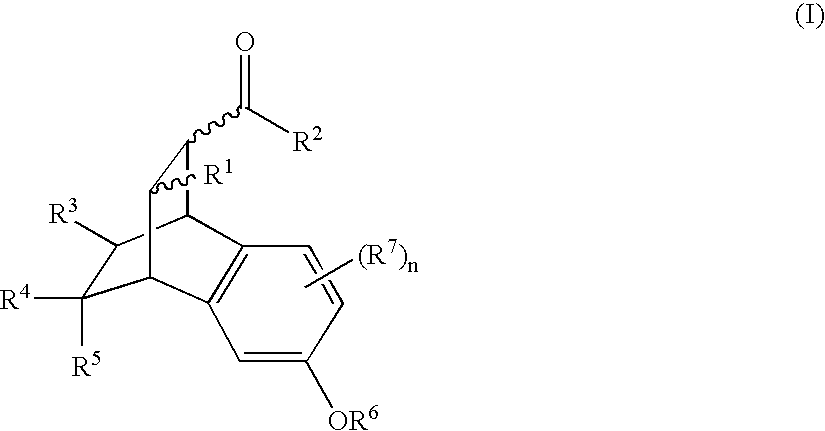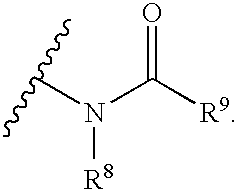Pharmaceutical uses and synthesis of benzobicyclooctanes
a technology of benzobicyclooctanes and benzobicyclooctanes, which is applied in the preparation of urea derivatives, amide active ingredients, organic compounds of the group 5/15 element, etc., can solve the problems of long and laborious optimization process, inability to add significant numbers of new structures to the compound collections used in the initial screening step of the discovery and optimization process, and inability to achieve traditional one-at-a-time synthesis methods. ,
- Summary
- Abstract
- Description
- Claims
- Application Information
AI Technical Summary
Benefits of technology
Problems solved by technology
Method used
Image
Examples
example 1
Synthesis of 4-Hydroxy-11-oxo-tricyclo[6.2.2.02,7]dodeca-2(7),3,5-triene-9,10-dicarboxylic acid 9-(2-trimethylsilylethyl) ester
[0244]
A. 4-Hydroxy-11-oxo-tricyclo[6.2.2.02,7]dodeca-2(7),3,5-triene-9,10-dicarboxylic acid anhydride
[0245]A solution of dihydroxynaphthalene (500 g, 3.125 mol) and maleic anhydride (765 g, 7.815 mol, 2.5 eq) in 1 L 1:1 1,2-dichlorobenzene:toluene were heated at 110° C. for 3 days. The reaction mixture was then cooled to 90° C., 1.5 L ethyl acetate added, and then further cooled to room temperature overnight. The mixture was then cooled over ice after another 0.5 L ethyl acetate was added and left stirring for 2 hours. The resultant solid was isolated by filtration, washed with 2×200 mL cold ethyl acetate and dried in oven at 40° C. to provide 130 g of the anhydride as a beige solid (16% yield). 1H NMR (acetone-d6) 7.33 (d, J=8.2 Hz, 1H), 6.97 (d, J=2.3 Hz, 1H), 6.85 (dd, J=8.1, 2.4 Hz, 4.05 (d, J=3.9 Hz, 1H), 3.98 (dd, J=6.0, 2.9 Hz, 1H), 3.88 (dd, J=10.2, ...
example 2
Synthesis of (4-Hydroxy-11-oxo-tricyclo[6.2.2.02,7]dodeca-2(7),3,5-triene-9,10-dicarboxylic acid 10-(2-trimethylsilanyl-ethyl) ester)
[0247]
[0248]DMAP (0.5 g, 4 mmol, 10 mol %) and trimethylsilylethanol (6.6 mL, 5.45 g, 46 mmol) were added to a stirred suspension of the anhydride (10.83 g, 42 mmol) from Example 1.A in 400 mL acetonitrile and heated to reflux for 6 h. The volatiles were evaporated, and the resulting foam was chromatographed on silica gel (20% acetonitrile / dichloromethane with 2% AcOH). Appropriate fractions were combined and dichloromethane and toluene were used to remove residual AcOH. Repeated trituration of the less polar product with ethyl ether provided 4.9 g (31%) of the title compound. 1H NMR (acetonitrile-d3) 7.13 (d, J=8.0 Hz, 1H), 6.75 (d, J=2.2 Hz, 1H), 6.72 (dd, J=8.0, 2.5 Hz, 1H), 4.17-4.11 (m, 2H), 3.64-3.62 (m, 1H), 3.60 (d, J=3.0 Hz, 1H), 3.22 (dd, J=11.8, 3.0 Hz, 1H), 2.97 (dt, J=11.8, 2.2 Hz, 1H), 2.87 (dd, J=18.7, 2.2 Hz, 1H), 2.08 (ddd, J=18.4, 3.3...
example 3
Synthesis of (9,10 cis)-10-Allyloxycarbonylamino-4-hydroxy-11-oxo-tricyclo[6.2.2.02,7]dodeca-2(7),3,5-triene-9-(2-Trimethylsilanyl-ethyl) ester
[0249]
[0250]To a solution of acid 1 (196 mg, 0.52 mmol) in THF (25 mL) was added DPPA (230 μL, 1.05 mmol), triethylamine (150 μL, 1.08 mmol), and allyl alcohol (360 μL, 5.3 mmol). The mixture was heated to reflux and held for 15 h. Upon cooling, the mixture was concentrated in vacuo, and the residue chromatographed, initially with 30% ethyl acetate / hexane followed by a second chromatography using 15% ethyl acetate / dichloromethane to afford a total of 65.8 mg (30%) of the title compound. ESI-MS m / z 454 (MNa+).
PUM
 Login to View More
Login to View More Abstract
Description
Claims
Application Information
 Login to View More
Login to View More - R&D
- Intellectual Property
- Life Sciences
- Materials
- Tech Scout
- Unparalleled Data Quality
- Higher Quality Content
- 60% Fewer Hallucinations
Browse by: Latest US Patents, China's latest patents, Technical Efficacy Thesaurus, Application Domain, Technology Topic, Popular Technical Reports.
© 2025 PatSnap. All rights reserved.Legal|Privacy policy|Modern Slavery Act Transparency Statement|Sitemap|About US| Contact US: help@patsnap.com



